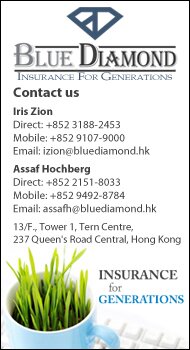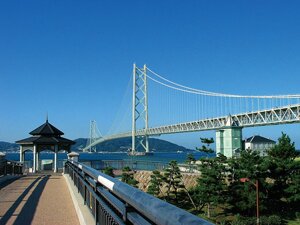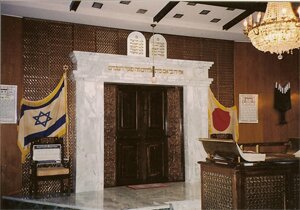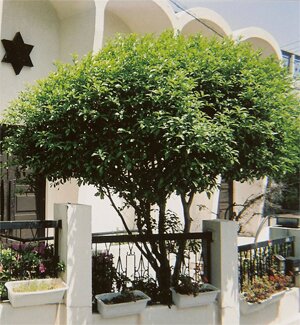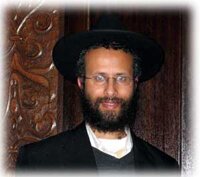Warning: Parameter 1 to plgContentLoginToRead::onAfterDisplayTitle() expected to be a reference, value given in /home/joomla789/domains/jewishtimesasia.org/public_html/libraries/joomla/event/event.php on line 67
| Kobe, Japan - Jewish Community |

|

|
|
In the Kansai region of the island of Honshu, Japan, sits the port city of Kobe. The cosmopolitan city has a population of 45,000 foreign residents from more than 100 countries and is home to the Ohel Shelomo Synagogue, officially the Jewish Community of Kansai- the oldest surviving Jewish community in Japan.
 The first Jews arrived in Kobe around the turn of the 20th century. Up until World War II, Jews flocked to the port city from Poland, Russia, Germany, and the Middle East due to its wealth and trading opportunities. As was often the case in Jewish history, Jews were predominantly involved in mercantile businesses because of limitations imposed upon then by their home countries, and working in trade allowed them to prosper without settling down. By 1941, there were two separate synagogues in Kobe, one for the Ashkenazim and another for the Sephardim. During World War II, the Sephardic synagogue burnt down as the result of an American air raid, and the Ashkenazim shared their space with the Sephardic community.
According to George Sidline, a former resident of Kobe who now lives in Portland, Oregon, during the war, the Germans went to great lengths to infiltrate Japan with anti-Semitic propaganda, yet to their annoyance, Japan was largely tolerant of Jews. He is currently writing a book about his experiences growing up in Japan during the war. There have been numerous other publications on the subject. Ironically, in the 1930s, the Japanese government, espoused by the fraudulent anti-Semitic text “The Protocols of the Elders of Zion,†which claimed that Jews had an intrinsic and almost supernatural ability to accumulate money and power, sought out a Jewish population to come to Japan. The government believed that encouraging Jews to settle in their country would be politically and economically advantageous. Between 1939 and 1940, despite being an ally of Nazi Germany, Japan continued to accept a large influx of Jews from Europe. In a well-known act of bravery and kindness, Japan’s consul to Lithuania, Chiune Sogihara, ignored orders from Japan’s Foreign Ministry and gave thousands of Jews transit visas to Japan- many of whom found refuge in Kobe- saving as many as 10,000 Jewish lives. The Jews in Kobe meanwhile found themselves unable to travel or conduct business during the war, but were treated well by local authorities. It is reported that Rahmo Sassoon, in order to ease the growing anxiety among the Jewish residents, was pressured into painting over the gold lettered sign that adorned the synagogue so that it would be less conspicuous.  Despite the presence of German officers in Kobe, the Chief of Police of Kobe assured Sassoon of the community’s safety and he was ordered to restore the lettering. Â
The largest single group to benefit from Sugihara’s effort was the Lithuanian Mirrer Yeshiva, the only European institute of Talmudic learning that survived the Holocaust. The yeshiva also had the good fortune to be associated with a member of the extended Japanese imperial family who was enamored with Judaism.  Setzuso Kotsuji befriended the yeshiva’s rabbis and petitioned Japan’s Foreign Affairs minister to extend their two-week visas to eight months. The yeshiva then relocated from Kobe to Shanghai in 1941, where it remained until the end of the war. The yeshiva now resides in Jerusalem and in Brooklyn. After the war, most of the Jewish refugees had left Japan for other countries, and what remained of Kobe was the Sephardic community, which officially established itself as the Jewish Community of Kansai. It acquired a building from Rahmo Sassoon, a Syrian-born resident of Kobe, naming it Ohel Shelomo after his father. The plot of land and building were originally purchased for use as a furniture warehouse but were converted into a synagogue. The present community center was built in 1970, under the direction of Albert Hamway and Vicot Moche, who came from Syria and Iran, respectively, after the community raised funds and purchased the land from Rahmo Sassoon. The land was sold far below market value so that Rahmo Sassoon could further contribute to the community. For many years foreign business prospered and the Jewish community grew rapidly in size. Large Israeli companies created headquarters in the area, brining with them an influx of young families. Traders and other businessmen flocked to this commercial center on a regular basis and the shipping industry flourished. The Israeli presence was high. Unfortunately, a depreciation of the yen led many of these businesses to pull out in the 1980s. The current synagogue is located in Kitano-cho, not far from the center of commercial activity. The center exists to this day with donations from local residents, businessmen and travelers from around the world. Unfortunately, the Great Hanshin earthquake of 1995 caused serious damage to the building, which has since been repaired but still needs additional restoration work. Many members of the community watched as their homes and possessions were destroyed.  The nearby Jewish cemetery, a true testimony to the history of this community, also suffered severe damage, including cracked and overturned tombstones. As the cost of repairs is high and the community is much smaller than it had been, the struggle to return the center to its original grandeur appears to be ongoing. Numerous international organisations and private donors responded to the community’s needs in the aftermath. Although the Jewish community’s population has clearly declined quite drastically from its World War II population and its peak for the Israeli shipping industry, Kobe continues to be an active and vibrant community. Today the synagogue serves as the Jewish center for over twenty families and attracts Jews from neighbouring cities as well as tourists from around the world.  Any given Shabbas promises representation from the four corners of the globe and all spectrums of Jewish background and practice. As Kobe is known as a leading center for pearl trade, naturally many of the participants were drawn there by the nature of their industry. Others trade in rugs and other luxury items.  The community also attracts English teachers as well as students from Israel and the United States. Israeli backpackers, making their way through Asia, also find refuge in this community. The synagogue is Orthodox and Sephardic, but those who frequent it come from diverse Jewish backgrounds. The synagogue remains Orthodox but manages to incorporate this diverse groups uniqueness into daily life and encourages participation from all members of the community. Additionally, it is not uncommon for visitors to participate in the warm and welcoming Shabbat activities.  All participants are invited weekly to enjoy a sit down Kiddush following Shabbat services. A recent Passover sedar included two visiting rabbis from New York as well as nearly 180 participants. Haggagot in Japanese were made available.
Rabbi Asaf Tobi, sent by Chabad in Israel, serves as the synagogue’s permanent rabbi. Rabbi Tobi grew up in Jerusalem and was likewise educated and ordained there as well. Rebbetzin, Merav Tobi, received training as an elementary school teacher. It is clear that together Rabbi Asaf and Rebbetzin Merav place a great emphasis on education.  The community boasts a kindergarten program in response to demand. Their Gan Yeladim program is offered daily from Sunday through Thursday and incorporates Hebrew language lessons, weekly parsha introduction, and learning about the holidays and prayer. Their aim is to help the children internalise Jewish values.  Additionally, education is offered for women so that they can be better prepared to keep a home in accordance to Jewish law. Other adult education opportunities are also available to further the Rabbi and Rebbetzin’s self-proclaimed missions, to provide education to the community. Kosher food is available and the kosher market makes a wide range of products available to residents and travelers. Additionally, the community has a mikveh. All women are welcomed and encouraged to make use of the mikveh and learn about this important ritual. The community offers detailed explanations of the spiritual, psychological and physical benefits of mikveh, to those that may not familiar with the laws, in order to further the aim of education. The Jewish Community of Kansai is proud of its strong and unique history. They together have survived World War II and a devastating earthquake. The ties former residents have to the community remains strong. The community’s history has been well documented and recorded. Relatives of those who sought refuge there hold the community in a special place in their hearts.  A Japanese flag and an Israeli flag wave from the synagogue’s bima.  The Jewish Community of Kansai has stood the test of time and although small, continues to grow and thrive.  Historical portion adapted, with permission of author, Lisa Sopher. Article appeared, in part, in Blueprint- July/ August 2006 edition.  Fact Box Ohel Shlomo Synagogue (Issue October 2006) |







